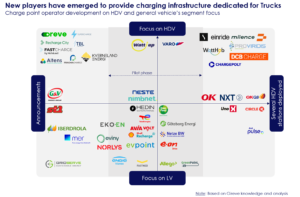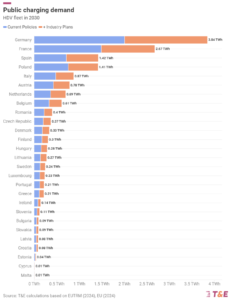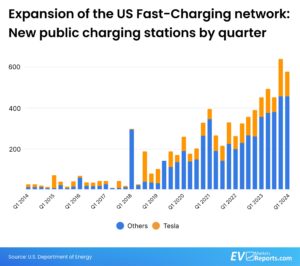The Growth of Fast Charging in Europe
Europe has established itself as a leader in BEV adoption alongside China, thanks to a combination of economic incentives, technological advancements, and supportive regulatory frameworks. The European market is diverse, with countries like Norway and the Netherlands leading in BEV adoption and charging infrastructure development. Norway, for instance, boasts an 18% BEV market share and a high rate of fast charging points, reflecting its early commitment to advanced charging technologies.
The study reveals that Europe has over 745,000 public charging points, of which more than 98,000 are fast charging points, constituting approximately 13% of the total infrastructure. Germany, France, and the UK, as the largest BEV markets, lead in the number of fast charging points, while Norway exhibits the best balance between the number of fast charging points and their ratio.
Key Factors Influencing Fast Charging Infrastructure
Several factors influence the deployment of fast charging infrastructure. There is a strong correlation between a country’s GDP per capita and its BEV market share, with wealthier nations like Norway, the Nordic countries, and the Netherlands leading in BEV adoption. Additionally, countries with extensive highway networks, such as France, Germany, Italy, and Spain, have significantly ramped up their fast charging infrastructure to facilitate long-distance BEV travel.
Strategic Deployment and Collaborative Efforts
Fast charging infrastructure is often strategically deployed along highways to support long-distance travel. Approximately one-third of all fast charging points in Europe are located on highways, with this figure rising to about half for charging points of 150 kW and above. Collaborative efforts among automakers have also played a crucial role. Ionity, a joint venture among BMW, Ford, Mercedes-Benz, Volkswagen, and Hyundai, has been instrumental in deploying fast charging stations across major European highways.
The involvement of retail groups in installing fast charging points in parking lots has further expanded the infrastructure. In France, the LOM legislation mandates that 5% of parking spaces be equipped with charge points, accelerating deployment at retail locations.
Policies and Standardisation
European policies like the ‘Fit-for-55’ initiative and the Alternative Fuel Infrastructure Directive (AFID) have been pivotal in supporting the expansion of fast charging networks. AFID’s revamp into the Alternative Fuel Infrastructure Regulation (AFIR) has set mandatory targets for fast charging deployment, focusing on the total power deployed per BEV and the number of fast charging points per highway segment.
Standardisation has also been essential. The Combined Charging System (CCS) has become the standard for fast charging, promoting interoperability and ease of use across Europe.
Key Milestones
The study outlines several key milestones in the development of fast charging infrastructure:
- 2012: Publication of DIN SPEC 70121 and introduction of the Combo 2 connector (CCS).
- 2013: Installation of the first Tesla superchargers and creation of roaming hubs like Hubject and Gireve.
- 2014: AFID mandates the use of Combo 2 connectors for EV chargers.
- 2015: Creation of CharIN to promote the CCS connector.
- 2018: Adoption of CCS version 2.0 and deployment of the first Ionity stations.
- 2021: Opening of the Tesla network to non-Tesla drivers.
- 2023: Implementation of ad-hoc payment requirements and further expansion of Tesla’s roaming capabilities.
Conclusion
Europe’s fast charging network has evolved significantly, driven by economic factors, strategic deployment, and collaborative efforts. The insights from Gireve’s study underscore the importance of continued investment, standardisation, and policy support in expanding the fast charging ecosystem. These lessons not only benefit Europe but also offer valuable guidance for other regions on their electrification journeys.
Source: Gireve




